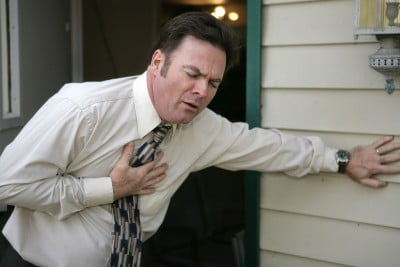- Updated on November 1, 2020
![]() By Dr. Artour Rakhimov, Alternative Health Educator and Author
By Dr. Artour Rakhimov, Alternative Health Educator and Author
- Medically Reviewed by Naziliya Rakhimova, MD
Hypertension, Migraine Headaches, and Panic Attacks
Module 8A. Restrictions, side effects, limits, and temporary contraindications
(Learning the Buteyko method by modules)
All these health conditions are successfully treated with breathing retraining. For example, breathing students with 30 s morning CP have normal blood pressure naturally (i.e., without medications that reduce blood pressure) even if they suffered from hypertension when they started breathing retraining. Similarly, panic attacks and most (but not all) migraines also disappear with easier breathing 24/7.
However, there are certain restrictions for these groups of people before they get to their better health. In fact, depending on the severity and type of the condition and some other personal factors, many of these patients can worsen their health state if they try common (usual) or intensive breathing sessions accompanied by quick CO2 increases. Predisposed patients can develop even higher blood pressure, panic attacks, and migraine headaches due to (wrong) breathing exercises.
 Even CP measurement can trigger negative cardiovascular changes in some students with hypertension. Note that other groups of people can do breath holds without any negative effects of hypertension, but blood vessels of some students with hypertension can constrict due to too quick changes in blood gas composition.
Even CP measurement can trigger negative cardiovascular changes in some students with hypertension. Note that other groups of people can do breath holds without any negative effects of hypertension, but blood vessels of some students with hypertension can constrict due to too quick changes in blood gas composition.
This effect was known to Dr. K. Buteyko who described it in his medical publications in the 1960s.
Many of these patients (with high blood pressure, migraine headaches, or panic attacks) can safely do and get benefits from the same breathing exercises (with the DIY breathing device and the reduced breathing developed by Dr. Buteyko for hypertension). However, in order to be safe in relation to all students, it is better for these people to start with lighter forms of breathing exercises.
When using the DIY breathing device:
1. Follow the guidelines outlined in the book “Amazing DIY Breathing Device”.
When doing Buteyko breathing exercises, various pauses, and reduced breathing:
If you feel uncomfortable/overstressed after doing the CP test and any other pauses (including maximum and extended pauses) and your heart rate get higher (3-5 min after the test), do not do any breath holds.
It is a known effect that some groups of people get a different cardiovascular response to sudden and sharp changes in arterial CO2. Breathing sessions and exercises should lead to higher CP, lower heart rate and an improved feeling of well-being. Hence, you need to adjust your breathing exercises to your current (temporary) state by avoiding uncomfortable pauses and focusing on reduced breathing.
Start with the relaxation of the diaphragm exercise that does not create any sensation of air hunger. Practice this exercise for several days and then try the CP test. Later you can proceed to more demanding exercises and start practicing reduced breathing without any pauses (as it is described on the web page Learn Buteyko reduced breathing).
When breathing, after some days/weeks of practice becomes lighter, the ability to do pauses is improved (you can safely do, for example, the CP measurement) and they are safe and useful to do. For example, with over 20 s CP such people are comfortable doing the CPs and even practicing reduced breathing immediately after the CP without any unpleasant sensations. Then you can practice a regular Buteyko breathing exercise session.
When such students (panic attacks, heart disease, or migraine headaches) get over X s morning CP (see details below), no restrictions are usually necessary, extended and maximum pauses are safe, and these students can join the main group in further breathing normalization.
You can find out this number X below, as well as the main suggestion that allows these students to temporarily monitor and control the effectiveness of their breathing exercises without the CP test.
These students need to have 25-30 s for the morning CP to start or resume more intensive breathing sessions. Some of them can try intensive sessions and long breath holds even at 20 s morning CP and it can be safe.
For feedback (monitoring), these students should use their heart rate (pulse), before and after breathing sessions.
[/sociallocker]
Keep in mind, that at any stage, it is important that you feel better after the breathing sessions and your heart rate should become lower either immediately after the breathing session or 5-10 minutes later.
Important note for patients with high blood pressure
Within 3-4 days after starting breathing retraining hypertension experience a better quality of life (more energy, better concentration, alertness, sleep, and digestion). However, they often experience an increase in blood pressure (up to 20-30 mm Hg) during the first 5-7 days of breathing retraining. During the following 2-6 weeks, their blood pressure gets back to normal. It is very important for them to practice regularly in order to achieve clinical remission (cure) of hypertension.
When practicing the relaxation of the diaphragm (special Buteyko breathing exercise for patients with high blood pressure), these patients should avoid any air hunger or sensation of a shortage of air.
These restrictions and conditions are for people with:
– Heart disease (aortic aneurysms; angina pectoris; arrhythmia; atherosclerosis (plaque buildup); cardiomyopathy; ciliary arrhythmia (cardiac fibrillation); chest pain (angina pectoris); high cholesterol; chronic ischemia; congenital heart disease; congestive heart failure; coronary artery disease; endocarditis; extrasystole; heart murmurs; hypertension; hypertrophic cardiomyopathy; pericarditis; post-myocardial infarction; stroke; tachycardia)
– Migraine headaches and panic attacks
– This page in Spanish: La hipertensión, enfermedades del corazón, migrañas, ataques de pánico.

